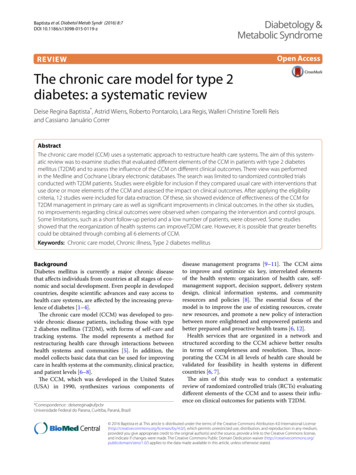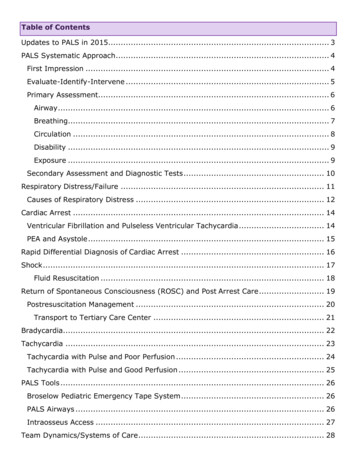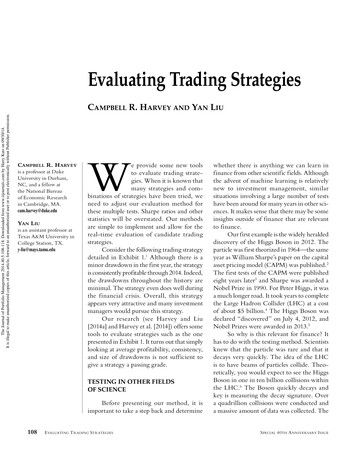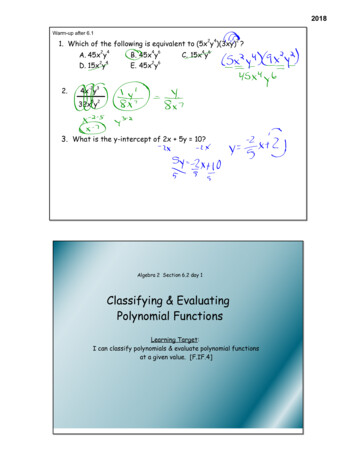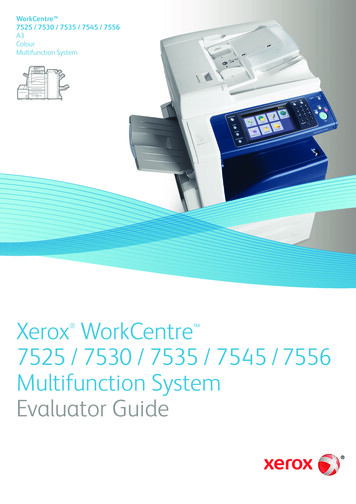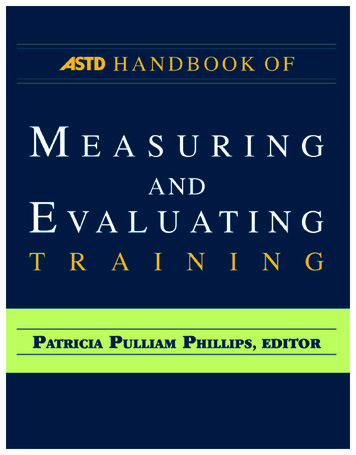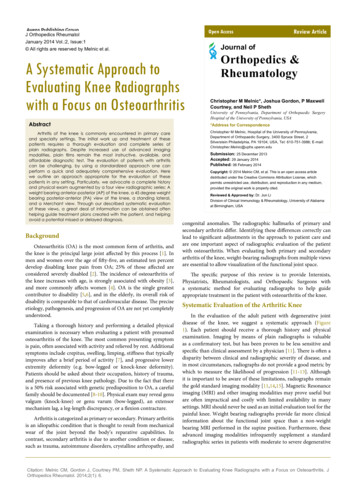
Transcription
Open AccessJ Orthopedics RheumatolJanuary 2014 Vol.:2, Issue:1 All rights are reserved by Melnic et al.Journal ofA Systematic Approach toEvaluating Knee Radiographswith a Focus on OsteoarthritisAbstractArthritis of the knee is commonly encountered in primary careand specialty settings. The initial work up and treatment of thesepatients requires a thorough evaluation and complete series ofplain radiographs. Despite increased use of advanced imagingmodalities, plain films remain the most instructive, available, andaffordable diagnostic test. The evaluation of patients with arthritiscan be challenging, by using a standardized approach one canperform a quick and adequately comprehensive evaluation. Herewe outline an approach appropriate for the evaluation of thesepatients in any setting. Particularly, we advocate a complete historyand physical exam augmented by a four view radiographic series: Aweight bearing anterior-posterior (AP) of the knee, a 45 degree weightbearing posterior-anterior (PA) view of the knee, a standing lateral,and a Merchant view. Through our described systematic evaluationof these views, a great deal of information can be obtained oftenhelping guide treatment plans created with the patient, and helpingavoid a potential missed or delayed diagnosis.BackgroundOsteoarthritis (OA) is the most common form of arthritis, andthe knee is the principal large joint affected by this process [1]. Inmen and women over the age of fifty-five, an estimated ten percentdevelop disabling knee pain from OA; 25% of those affected areconsidered severely disabled [2]. The incidence of osteoarthritis ofthe knee increases with age, is strongly associated with obesity [3],and more commonly affects women [4]. OA is the single greatestcontributor to disability [5,6], and in the elderly, its overall risk ofdisability is comparable to that of cardiovascular disease. The preciseetiology, pathogenesis, and progression of OA are not yet completelyunderstood.Taking a thorough history and performing a detailed physicalexamination is necessary when evaluating a patient with presumedosteoarthritis of the knee. The most common presenting symptomis pain, often associated with activity and relieved by rest. Additionalsymptoms include crepitus, swelling, limping, stiffness that typicallyimproves after a brief period of activity [7], and progressive lowerextremity deformity (e.g. bow-legged or knock-knee deformity).Patients should be asked about their occupation, history of trauma,and presence of previous knee pathology. Due to the fact that thereis a 50% risk associated with genetic predisposition to OA, a carefulfamily should be documented [8-10]. Physical exam may reveal genuvalgum (knock-knee) or genu varum (bow-legged), an extensormechanism lag, a leg-length discrepancy, or a flexion contracture.Arthritis is categorized as primary or secondary. Primary arthritisis an idiopathic condition that is thought to result from mechanicalwear of the joint beyond the body’s reparative capabilities. Incontrast, secondary arthritis is due to another condition or disease,such as trauma, autoimmune disorders, crystalline arthropathy, andReview ArticleOrthopedics &RheumatologyChristopher M Melnic*, Joshua Gordon, P MaxwellCourtney, and Neil P ShethUniversity of Pennsylvania, Department of Orthopaedic SurgeryHospital of the University of Pennsylvania, USA*Address for CorrespondenceChristopher M Melnic, Hospital of the University of Pennsylvania,Department of Orthopaedic Surgery, 3400 Spruce Street, 2Silverstein Philadelphia, PA 19104, USA, Tel: 610-751-3986; : 25 December 2013Accepted: 29 January 2014Published: 06 February 2014Copyright: 2014 Melnic CM, et al. This is an open access articledistributed under the Creative Commons Attribution License, whichpermits unrestricted use, distribution, and reproduction in any medium,provided the original work is properly cited.Reviewed & Approved by: Dr. Jun LiDivision of Clinical Immunology & Rheumatology, University of Alabamaat Birmingham, USAcongenital anomalies. The radiographic hallmarks of primary andsecondary arthritis differ. Identifying these differences correctly canlead to significant adjustments in the approach to patient care andare one important aspect of radiographic evaluation of the patientwith osteoarthritis. When evaluating both primary and secondaryarthritis of the knee, weight-bearing radiographs from multiple viewsare essential to allow visualization of the functional joint space.The specific purpose of this review is to provide Internists,Physiatrists, Rheumatologists, and Orthopaedic Surgeons witha systematic method for evaluating radiographs to help guideappropriate treatment in the patient with osteoarthritis of the knee.Systematic Evaluation of the Arthritic KneeIn the evaluation of the adult patient with degenerative jointdisease of the knee, we suggest a systematic approach (Figure1). Each patient should receive a thorough history and physicalexamination. Imaging by means of plain radiographs is valuableas a confirmatory test, but has been proven to be less sensitive andspecific than clinical assessment by a physician [11]. There is often adisparity between clinical and radiographic severity of disease, andin most circumstances, radiographs do not provide a good metric bywhich to measure the likelihood of progression [11-13]. Althoughit is important to be aware of these limitations, radiographs remainthe gold standard imaging modality [11,14,15]. Magnetic Resonanceimaging (MRI) and other imaging modalities may prove useful butare often impractical and costly with limited availability in manysettings. MRI should never be used as an initial evaluation tool for thepainful knee. Weight bearing radiographs provide far more clinicalinformation about the functional joint space than a non-weightbearing MRI performed in the supine position. Furthermore, theseadvanced imaging modalities infrequently supplement a standardradiographic series in patients with moderate to severe degenerativeCitation: Melnic CM, Gordon J, Courtney PM, Sheth NP. A Systematic Approach to Evaluating Knee Radiographs with a Focus on Osteoarthritis. JOrthopedics Rheumatol. 2014;2(1): 6.
Citation: Melnic CM, Gordon J, Courtney PM, Sheth NP. A Systematic Approach to Evaluating Knee Radiographs with a Focus on Osteoarthritis. JOrthopedics Rheumatol. 2014;2(1): 6.ISSN: 2334-2846Adult with Knee PainHistrory and PhysicalSuspected arthritisNoYesWeight bearing AP, 45 degrees PA, Lateral, Merchant ViewFurther work-up of knee painNormal x-rays?YesNoX-ray findingsAsymmetric joint space narrowingOsteophyte formationSubchondral cyst formationSubchondral sclerosisOsteoarthritisSymmetric joint space narrowingBony erosionsPeriarticular osteopeniaSoft tissue swellingJoint ankylosisInflammatory arthritisConsider advanced imaging/other diagnostic modalitiesChondrocalcinosisJoint space narrowingPatellofemoral jointinvolvementSquaring patellaFlattened femoral condylesWidened intercondylar notchJoints space narrowingSubarticular cysisCrystaline ArthropathyHemophilla associated arthritisRefer to RheumatologyRefer to Orthopaedics ifconservative treatment failsRefer to HematologyFigure 1: A schematic flow chart depicting a systematic approach to knee radiographs.joint disease.Following the history and physical in a patient with suspectedarthritis, a full series of knee radiographs should be obtained.Each view allows for evaluation of a different aspect of the kneeand together they depict a clear picture of the state of the disease.Although there is continued debate over which views optimize athorough radiographic evaluation [16-18], we advocate the followingseries: a (1) weight bearing anteroposterior (AP), a (2) weight bearing45 degree posteroanterior (PA) (Rosenberg view) [19], a (3) standinglateral, and an (4) axial view, in particular the Merchant view [20].Oblique radiographs of the knee are not required for the initial kneeradiographic evaluation; these x-ray images may offer benefit in theevaluation of fractures about the knee joint, but are not helpful inevaluating knee arthritis.The above-mentioned series of radiographs allows for thecomplete evaluation of the three compartments of the knee: thepatellofemoral (PF), medial tibiofemoral, and lateral tibiofemoral(TF) compartments. Degenerative changes may be found in anycombination, but often only involve one or two of the compartments.Each radiograph in this complete series can be evaluated first forJ Orthopedics Rheumatol 2(1): 6 (2014)quality and then for pathology. In primary osteoarthritis, the classicradiographic features include osteophyte formation, loss of jointspace, subchondral cysts, subchondral sclerosis, and, occasionally, thepresence of loose bodies [14,21,22].The weight bearing AP (Figure 2) should be obtained in fullextension with the patient standing. The quality of the AP view can bedetermined by observing the fibular head in relation to the tibia. In anormal knee, the fibular head is approximately one centimeter belowthe tibial plateau and one fourth of the head will overlap the tibia. Ina knee with substantial deformity or bone loss, these landmarks maybe altered. This view will allow for visualization of both the medialand lateral tibial plateaus as well as the anatomic morphology of thefemoral condyles. This is also the best view for evaluation of overallvarus and valgus deformity of the lower extremity. Key features of theAP include the medial and lateral TF joint space, often slightly greaterthan 5mm, but notoriously difficult to measure consistently [5,12,18].Osteophyte formation is often present in the involved compartmentsand has more reliably been associated with pain than joint spacenarrowing [23,24]. The medial and lateral TF joints can also beevaluated for the presence of subchondral cysts and subchondralsclerosis. These appear as small irregular radiolucencies or increasedlinear radiodensities just beneath the joint surface, respectively.Page - 02
Citation: Melnic CM, Gordon J, Courtney PM, Sheth NP. A Systematic Approach to Evaluating Knee Radiographs with a Focus on Osteoarthritis. JOrthopedics Rheumatol. 2014;2(1): 6.ISSN: 2334-2846The forty-five degree PA (Figure 3) radiograph allows fordetection of early arthritic changes not readily visible on the standingAP radiograph [25]. In his original article, Rosenberg noted, “themost frequently involved zones of articular cartilage were the contactareas of the knees that were between 30 and 60 degrees of flexion”[19]. The patient should stand with both knees flexed to forty-fivedegrees. The extremity should be positioned so that the femur andthe tibia are at twenty-five and twenty degree angles from the cassetterespectively with the x-ray beam positioned 10 degrees caudad[19]. As the knee flexes, the axis of rotation translates posteriorly.Obtaining a radiograph with flexion of the knee to forty-five degreesallows the posterior aspect of the joint to be visualized, a commonregion of the joint to be involved in osteoarthritis. The Rosenberg viewalso allows for pathology of the intercondylar notch to be evaluated.Specific pathologies include osteochondritis dissecans, osteonecrosis,presence of osteophytes, and loose bodies [25,26].The lateral view (Figure 4) allows for evaluation of the posterioraspect of the knee, as well as patellar position and tibial slope. A highquality lateral image is defined by overlap of the femoral condyles andtibial plateaus. The tibia usually has about a 7-degree posterior slopeand the lateral (convex) plateau sits slightly more proximal than themedial (concave) plateau. Additionally, the medial femoral condyle isvisualized just distal to the lateral femoral condyle. The lateral condylecan be identified by the presence of a subtle depression known asthe sulcus terminalis (embryologic remnant of the formation of theanterior horn of the lateral meniscus). The presence of osteophytes,specifically posterior, can be assessed. The medial and lateral TFjoints can again be evaluated for the presence of subchondral cystsand subchondral sclerosis.On the lateral radiographic projection, the patellar position canbe evaluated by use of the Insall-Salvati ratio (adapted from Insall andSalvati’s method described in 1971) [27]; this is a comparison ratioof the length of the patellar tendon to the length of the patella [27].The patellar length is defined as the greatest diagonal distance acrossthe patella and the tendon length is defined as the posterior borderof the patellar tendon from the inferior pole to the tibial tuberosity.The normal ratio is approximately 1.0; a 20% deviation increasing ordecreasing tendon length as compared to patellar length is referredFigure 2: Weight bearing anteroposterior radiograph of the knee. Note thepresence of preserved medial and lateral joint space on the left. The fibularhead lies 1 cm below the tibial plateau as indicated by the bracket. On theright, joint space narrowing, subchondral sclerosis and cystic changes, aswell as osteophytes are seen, which are indicative of osteoarthritis.J Orthopedics Rheumatol 2(1): 6 (2014)IIIIIIIVFigure 3: Standing AP knee radiographs (I and III) and 45-degree flexionposteroanterior views of the knee (II and IV). Radiographs III and IVdemonstrate the degenerative changes of OA while radiographs I and IIillustrate a preserved joint space. Flexion of the knee to forty-five degreesenhances the loss of articular cartilage and allows the aspect of the joint(posteromedial) that is most involved in the degenerative process to bevisualized (white arrow).Figure 4: Weight bearing lateral radiograph of the knee. Note the overlapof the medial and lateral femoral condyles indicating a properly rotatedradiograph (left). The sulcus terminalis identifies the lateral femoral condyle(Yellow Arrow). (A) The medial plateau is concave, while (B) the lateralplateau is convex. The patella height is within normal limits. On the right is alateral radiograph depicting osteoarthritis of the knee. Subchondral sclerosis,patellar osteophytes, and tibiofemoral joint space narrowing can be seen.to as patella alta or baja, respectively. Although PF joint space maybe seen on this view, and the presence of patellar osteophytes may beevaluated, it is better and more accurately evaluated on the Merchantview.The Merchant view (Figure 5) can be obtained by having thepatient lie supine on the table with the knee flexed and supportedat a 45-degree angle. The cassette should be placed below the legand perpendicular to the support with the beam directed 60 degreescaudad from a line perpendicular to the table and pointed at the knee[28]. This view allows for excellent visualization of the patellofemoraljoint and analysis of the joint space for osteophytes, subchondralcysts, and sclerosis. As an axial view, it has been proven superiorto the sunrise view in evaluation of the joint space and for patellarsubluxation [20,28]. This view specifically allows for measurement ofthe sulcus and congruence angles. The sulcus angle is simply the anglecreated by the intersection of the two lines drawn from the highestpoint on each condyle to the deepest portion of the intercondylarPage - 03
Citation: Melnic CM, Gordon J, Courtney PM, Sheth NP. A Systematic Approach to Evaluating Knee Radiographs with a Focus on Osteoarthritis. JOrthopedics Rheumatol. 2014;2(1): 6.ISSN: 2334-2846sulcus; this measurement is normally approximately 138 degrees.The congruence angle is measured as the angle of intersection of aline drawn from the deepest portion of the sulcus to the apex of thepatella (anterior-most point), and a line from the deepest portionof the sulcus to the posterior-most aspect of the articular surface ofthe patella. This typically measures -6 degrees /- 11 degrees, withnegative or positive angles set by convention [20,28].Varus and valgus deformities (Figure 6) are present when thenormal anatomic relationship between the tibia and femur is alteredin the coronal plane. A knee deformity with a medially directed apexindicates a valgus deformity and laterally directed apex indicates avarus deformity; varus deformities of the knee are more commonlyencountered. This is specifically evaluated by the anatomic axis ofthe leg, namely the intersection of the lines down the center of thefemoral and tibial diaphysis. The anatomic axis of the femur is usuallyin about 5-7 degrees of valgus and the tibia is in approximately 3degrees of varus; the normal range between these is approximately7-10 degrees. Amongst all factors, significant varus or valgusdeformity, particularly involving bone loss, may be the best indicatorof potential disease progression [29-31].In addition to the radiographs in our proposed systematicapproach, several other views have been suggested in the literature.The Lyon Schuss view, which aligns the radiographic beam with themargins of the medial tibial plateau while the knee is in 20-30 degreesof flexion, has been discussed as an alternative to the forty-five degreePA. However, it has been shown that proper alignment of the tibialplateaus is difficult to achieve and is important in assessing diseaseprogression [32,33]. Buckland-Wright, et al, recommended a fixedflexion or a non-fluoroscopic metatarsophalangeal view to evaluatethe tibiofemoral joint and a standing skyline radiograph to visualizethe patellofemoral joint [34]. Despite this, we recommend a Merchantview, as previously stated, because it has been proven superior to thesunrise view for evaluating the patellofemoral joint space [20,28].Treatment of patients with osteoarthritis of the knee is oftenchallenging and in the later stages of disease, total joint replacementhas been demonstrated to be safe and extremely effective [35].With increasing demand from the aging baby-boomer population,it is important to evaluate when referral to an Orthopedic Surgeonmay be indicated. In patients who suffer from moderate pain thatis interfering with their daily lives, particularly those with painFigure 5: Merchant view of the knee allowing for proper visualization of thepatellofemoral joint. On the left, (A) The sulcus angle is the line between thepeaks of each femoral condyle and the deepest point of the trochlear grooveand is approximately 138 degrees. (B) The congruence angle is shown aswell and is an average of 6 degrees. On the right, the degenerative changesof OA can be seen. There is loss of patellofemoral joint space, as well as,subchondral sclerosis and osteophytes.J Orthopedics Rheumatol 2(1): 6 (2014)CABFigure 6: Standing AP and lateral views of the right knee in a 65 year oldfemale with osteoarthritis.(A) Note the complete loss of medial joint space and resultant varus deformity.Radiographs also demonstrate(B) subchondral cyst formation and sclerosis, as well as(C) osteophyte formation.unresponsive to activity modification, anti-inflammatory treatment,physical therapy and intra-articular steroids or viscosupplementation,a referral to discuss possible surgical intervention is warranted.Current definitive guidelines do not exist; however, surgery has beenproven to substantially improve these patients’ quality of life.Radiographic Hallmarks of other Joint DiseasesEvaluation of secondary arthritis requires the same fourradiographs. The underlying etiology can often be heralded by keyradiographic features, which can help differentiate knee pain causedby secondary conditions. Here we outline some of the commoncauses of secondary arthritis and the radiographic features useful indiagnosis.Rheumatoid arthritis (RA) is an inflammatory condition that ispolyarticular in nature. Inflammatory arthropathies are characterizedby bony erosions, which are appreciated on radiographs asdiscontinuities of the subchondral bone, typically at the joint margins[33]. Osteopenia, symmetric joint space narrowing, soft tissueswelling, and if left untreated, joint ankylosis are all common findingson radiographs of RA (Figure 7) [36,37].Juvenile idiopathic arthritis (JIA) is the most common chronicarthritis of children. Osteopenia, soft tissue swelling, symmetric jointspace narrowing, enlargement of the distal femoral epiphysis, andepiphyseal overgrowth, thought to be due to chronic hyperemia canbe seen on radiographs. If left untreated, joint ankylosis and angulardeformities may be visualized. Due to the significant amount ofcartilage that must be destroyed in the pediatric knee in order forjoint erosions to be seen on radiographs, erosions are less likely to bepresent in young children [38].Joint destruction associated with hemophilia is also seen at ayoung age. Numerous intra-articular hemorrhages throughout ahemophiliac patient’s life may result in articular cartilage damagePage - 04
Citation: Melnic CM, Gordon J, Courtney PM, Sheth NP. A Systematic Approach to Evaluating Knee Radiographs with a Focus on Osteoarthritis. JOrthopedics Rheumatol. 2014;2(1): 6.ISSN: 2334-2846yielding chronic synovitis causing further joint destruction.Radiographic analysis typically demonstrates flattening of the distalfemoral condyles, enlargement and widening of the epiphysis,trabecular accentuation, widening of the intercondylar notch, andsquaring of the inferior margin of the patella [39]. The thickenedsynovium that results from this chronic process leads to marginalerosions and subarticular cyst formation. Joint effusion is typicallyencountered in the setting of an acute hemarthrosis.The knee is the most common joint affected by calciumpyrophosphate dihydrate (CPPD) deposition disease. The diagnosisis most commonly confirmed by knee joint aspiration, demonstratingthe presence of rhomboid shaped crystals in the synovial fluid that arepositively birefringent under a polarizing microscope. CPPD crystalsare deposited in the articular cartilage resulting in chondrocalcinosis,and the fibrocartilagenous structures of the knee become calcified andcan become evident radiographically. Calcification of the menisci isusually seen, and the lateral meniscus is most commonly involved. Onthe lateral radiograph, calcification of the gastrocnemius tendon mayalso be appreciated [40]. Degenerative changes in CPPD affect thepatellofemoral joint more frequently than the other compartments(Figures 8 and 9) [36].Figure 9: Intra-operative photo of the above 71 year old male with CPPDshowing deposition of CPPD crystals.Referral to a Rheumatologist should be considered when aninflammatory arthropathy is suspected. Initial management shouldconsist of medical management. If conservative measures have failedto control the patient’s pain, referral to an Orthopaedic Surgeonshould occur for a discussion regarding surgical options. Potentialinterventions include joint fusion or total knee arthroplasty.ConclusionOur systematic approach outlines a method for evaluatingthe patient with knee pain and suspected osteoarthritis. As such aprevalent condition, and one seen by nearly all medical specialties,our system provides a helpful guide regarding which radiographsto order, the correct technique to obtain to proper radiographicprojections, what key features to evaluate on each view, and in generalterms when to refer to a specialist. Initial radiographs should includefour views: a (1) weight bearing AP, a (2) weight bearing 45 degreePA, a (3) standing lateral, and a (4) Merchant view. Each radiographshould first be evaluated for quality and then for pathology. Ananalysis, performed in a stepwise fashion (Figure 1), allows thetreating physician to fully assess the radiographs of the osteoarthriticknee in a reproducible fashion.Figure 7: Standing AP radiograph of the knee in a 45-year-old patient withrheumatoid arthritis. In comparison with osteoarthritis, patients with RAdemonstrate symmetric joint space narrowing, periarticular osteopenia,periarticular erosions, and joint ankylosis.References1. Jordan KM, Arden NK, Doherty M, Bannwarth B, Bijlsma JW, et al. (2003)EULAR Recommendations 2003: an evidence based approach to themanagement of knee osteoarthritis: Report of a Task Force of the StandingCommittee for International Clinical Studies Including Therapeutic Trials(ESCISIT). Ann Rheum Dis 62: 1145-1155.2. Peat G, McCarney R, Croft P (2001) Knee pain and osteoarthritis in olderadults: a review of community burden and current use of primary health care.Ann Rheum Dis 60: 91-97.3. Felson DT, Anderson JJ, Naimark A, Walker AM, Meenan RF (1988) Obesityand knee osteoarthritis. The Framingham Study. Ann Intern Med 109: 18-24.4. Felson DT, Naimark A, Anderson J, Kazis L, Castelli W, et al. (1987)The prevalence of knee osteoarthritis in the elderly. The FraminghamOsteoarthritis Study. Arthritis Rheum 30: 914-918.5. Doherty M (2001) Risk factors for progression of knee osteoarthritis. Lancet358: 775-776.6. Jordan JM, Linder GF, Renner JB, Fryer JG (1995) The impact of arthritis inrural populations. Arthritis Care Res 8: 242-250.Figure 8: Standing AP and lateral radiographs of a 71 year old male withCPPD. Note the presence of chondrocalcinosis of the lateral hemijoint withsevere arthritic changes medially.J Orthopedics Rheumatol 2(1): 6 (2014)7. Ringdahl E, Pandit S (2011) Treatment of knee osteoarthritis. Am FamPhysician 83: 1287-1292.8. Felson DT, Lawrence RC, Dieppe PA, Hirsch R, Helmick CG, et al. (2000)Page - 05
Citation: Melnic CM, Gordon J, Courtney PM, Sheth NP. A Systematic Approach to Evaluating Knee Radiographs with a Focus on Osteoarthritis. JOrthopedics Rheumatol. 2014;2(1): 6.ISSN: 2334-2846Osteoarthritis: new insights. Part 1: the disease and its risk factors. Ann InternMed 133: 635-646.of osteoarthritis of the knee for epidemiological studies. Ann Rheum Dis 52:790-794.9. Spector TD and MacGregor AJ (2004) Risk factors for osteoarthritis: genetics.Osteoarthritis Cartilage 12: S39-S44.25. Messieh SS, Fowler PJ, Munro T (1990) Anteroposterior radiographs of theosteoarthritic knee. J Bone Joint Surg Br, 1990. 72: 639-640.10. Kerkhof HJ, Bierma-Zeinstra SM, Arden NK, Metrustry S, Castano-BetancourtM, et al. (2013) Prediction model for knee osteoarthritis incidence, includingclinical, genetic and biochemical risk factors. Ann Rheum Dis.26. Resnick D and Vint V (1980) The “Tunnel” view in assessment of cartilageloss in osteoarthritis of the knee. Radiology 137: 547-548.11. Hunter DJ, Guermazi A, (2012) Imaging techniques in osteoarthritis. PM R 4:S68-S74.12. Ding C, Zhang Y, Hunter D (2013) Use of imaging techniques to predictprogression in osteoarthritis. Curr Opin Rheumatol 25: 127-135.13. Bruyere O, Honore A, Rovati LC, Giacovelli G, Henrotin YE, et al. (2002)Radiologic features poorly predict clinical outcomes in knee osteoarthritis.Scand J Rheumatol 31: 13-16.27. Insall J and Salvati E (1971) Patella position in the normal knee joint.Radiology 101: 101-104.28. Greenspan A (2011) Orthopedic imaging : a practical approach. 5th Edition,Philadelphia: Lippincott Williams & Wilkins.29. Miyazaki T, Wada M, Kawahara H, Sato M, Baba H, et al. (2002) Dynamicload at baseline can predict radiographic disease progression in medialcompartment knee osteoarthritis. Ann Rheum Dis 61: 617-622.14. Altman RD, Gold GE (2007) Atlas of individual radiographic features inosteoarthritis, revised. Osteoarthritis Cartilage 15: A1-56.30. Cheung PP, Gossec L, Dougados M (2010) What are the best markers fordisease progression in osteoarthritis (OA)? Best Pract Res Clin Rheumatol24: 81-92.15. Altman RD, Hochberg M, Murphy WA Jr, Wolfe F, Lequesne M (1995) Atlasof individual radiographic features in osteoarthritis. Osteoarthritis Cartilage 3:3-70.31. Tanamas S, Hanna FS, Cicuttini FM, Wluka AE, Berry P, et al. (2009) Doesknee malalignment increase the risk of development and progression of kneeosteoarthritis? A systematic review. Arthritis Rheum 61: 459-467.16. Merle-Vincent F, Vignon E, Brandt K, Piperno M, Coury-Lucas F, et al.Superiority of the Lyon schuss view over the standing anteroposterior viewfor detecting joint space narrowing, especially in the lateral tibiofemoralcompartment, in early knee osteoarthritis. Ann Rheum Dis 66: 747-753.32. Conrozier T, Favret H, Mathieu P, Piperno M, Provvedini D, et al. (2004)Influence of the quality of tibial plateau alignment on the reproducibility ofcomputer joint space measurement from Lyon schuss radiographic views ofthe knee in patients with knee osteoarthritis. Osteoarthritis Cartilage 12: 765770.17. Cromer MS, Bourne RM, Fransen M, Fulton R, Wang SC (2013)Responsiveness of quantitative cartilage measures over one year in kneeosteoarthritis: Comparison of radiography and MRI assessments. J MagnReson Imaging.18. Conrozier T, Vignon E (1996) Quantitative radiography in osteoarthritis:computerized measurement of radiographic knee and hip joint space.Baillieres Clin Rheumatol 10: 429-433.19. Rosenberg TD, Paulos LE, Parker RD, Coward DB, Scott SM (1988) Theforty-five-degree posteroanterior flexion weight-bearing radiograph of theknee. J Bone Joint Surg Am 70: 1479-1483.20. Merchant AC, Mercer RL, Jacobsen RH, Cool CR (1974) Roentgenographicanalysis of patellofemoral congruence. J Bone Joint Surg Am 56: 1391-1396.21. Kellgren JH and Lawrence JS (1957) Radiological assessment of osteoarthrosis. Ann Rheum Dis 16: 494-502.22. Krasnokutsky S, Samuels J, Abramson SB (2007) Osteoarthritis in 2007. BullNYU Hosp Jt Dis 65: 222-228.23. Cicuttini FM, Baker J, Hart DJ, Spector TD (1996) Association of pain withradiological changes in different compartments and views of the knee joint.Osteoarthritis Cartilage 4: 143-147.24. Spector TD, Hart DJ, Byrne J, Harris PA, Dacre JE, et al. (1993) DefinitionJ Orthopedics Rheumatol 2(1): 6 (2014)33. Vignon E, Piperno M, Le Graverand MP, Mazzuca SA, Brandt KD, et al.(2003) Measurement of radiographic joint space width in the tibiofemoralcompartment of the osteoarthritic knee. Comparison of standinganterioposterior Lyon schuss views. Arthritis Rheum 48: 378-384.34. Buckland-Wright C (2006)
Citation: Melnic CM, Gordon J, Courtney PM, Sheth NP. A Systematic Approach to Evaluating Knee Radiographs with a Focus on Osteoarthritis. J Orthopedics Rheumatol. 2014;2(1): 6. J Ortho

